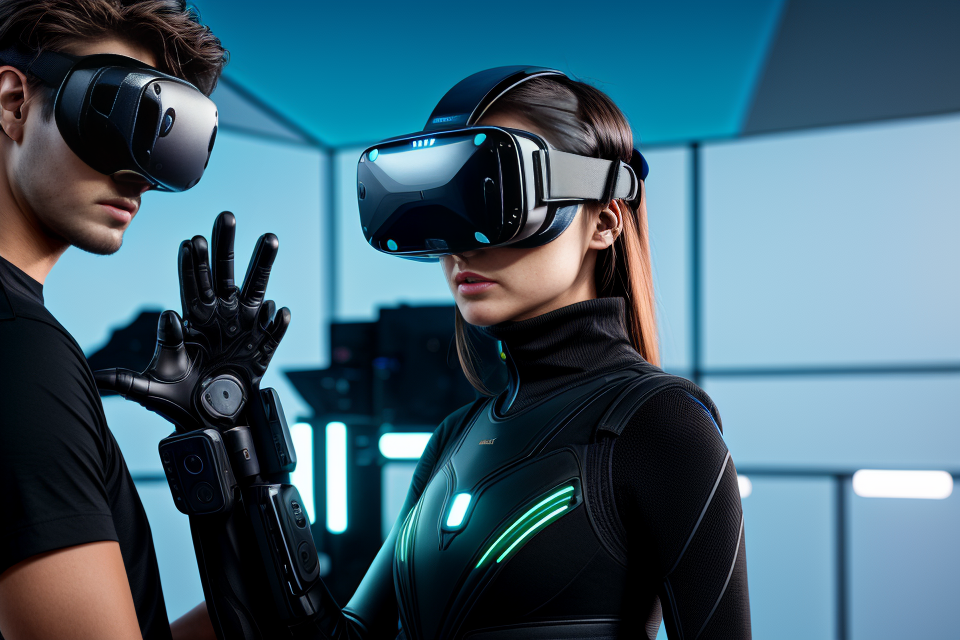
The world of wearables is constantly evolving, with new technologies and innovations emerging all the time. From smartwatches to fitness trackers, wearables have become an integral part of our daily lives, helping us to monitor our health and stay connected. But what’s next for wearables? In this article, we’ll take a comprehensive look at the emerging trends and technologies that are set to shape the future of wearables. From advanced biometric sensors to artificial intelligence, we’ll explore the cutting-edge technologies that are transforming the wearables industry. So buckle up and get ready to discover the next big thing in wearables!
Understanding the Current State of Wearables
The Evolution of Wearables
The evolution of wearables can be traced back to the early 1970s when the first generation of wearable technology was introduced. These early devices were primarily used for military and medical purposes and were bulky, expensive, and not very practical for everyday use. However, over the years, wearables have become more sophisticated, smaller, and more affordable, leading to their widespread adoption across various industries.
The rise of smartwatches and fitness trackers marked the second generation of wearables. These devices were designed to track health and fitness metrics, such as heart rate, steps taken, and calories burned. They also incorporated features like GPS and music playback, making them popular among athletes and fitness enthusiasts.
More recently, we have seen the emergence of hearables, which are wearable devices that can be inserted into the ear canal. These devices are designed to improve hearing or provide additional functionality, such as noise cancellation or voice assistance. Other specialized wearables include devices like smart glasses, which offer augmented reality (AR) experiences, and skin patches that monitor various health metrics.
Overall, the evolution of wearables has been driven by advancements in technology, such as miniaturization, increased processing power, and improved connectivity. As these devices continue to evolve, they are likely to play an increasingly important role in our daily lives, helping us to monitor our health, stay connected, and improve our overall well-being.
Market Analysis
- Global wearables market size and growth
- According to a recent report by IDC, the global wearables market grew by 27.5% in the second quarter of 2021, with a total of 121.4 million units shipped.
- The growth can be attributed to increased demand for smartwatches and hearables, as well as the expansion of wearables into new markets such as fashion and healthcare.
- Leading wearable device manufacturers
- Apple, Samsung, and Huawei are the top three manufacturers of wearable devices, accounting for over half of the global market share.
- Other notable players include Fitbit, Garmin, and Xiaomi.
- Major players in the wearables market
- In addition to device manufacturers, major players in the wearables market include software developers, app providers, and retailers.
- Google, Amazon, and Microsoft are all investing in wearables technology, with offerings such as Google Wear OS, Amazon Alexa, and Microsoft Health, respectively.
- Retailers such as Fitbit and Best Buy are also important players, as they offer a wide range of wearables and accessories to consumers.
Identifying the Next Big Thing in Wearables
Predicting Future Trends
- Identifying potential breakthrough technologies
- Artificial intelligence and machine learning
- Integration of AI into wearable devices for improved user experience
- Predictive analytics for personalized health and fitness monitoring
- Advanced materials and sensors
- Development of flexible and wearable sensors for improved data collection
- Integration of advanced materials for enhanced durability and comfort
- Artificial intelligence and machine learning
- Assessing the impact of emerging technologies on wearables
- The Internet of Things (IoT)
- Integration of wearables with other smart devices for seamless connectivity
- Expansion of wearable technology capabilities through IoT integration
- 5G and edge computing
- Enhanced data processing and transmission speeds for wearable devices
- Reduced latency for real-time monitoring and communication
- The Internet of Things (IoT)
- Understanding the role of consumer preferences and demands
- Personalization and customization
- Increased demand for wearables that cater to individual preferences and needs
- Development of customizable wearable devices to meet diverse user requirements
- Design and aesthetics
- Emphasis on wearable device design that is both functional and fashionable
- Integration of design elements that enhance the wearability and appeal of wearable devices
- Personalization and customization
Emerging Technologies and Breakthroughs
The world of wearables is constantly evolving, with new technologies and breakthroughs emerging that have the potential to revolutionize the industry. Here are some of the most exciting emerging technologies and breakthroughs in the field of wearables:
Artificial Intelligence and Machine Learning
Artificial intelligence (AI) and machine learning (ML) are two of the most exciting emerging technologies in the field of wearables. By incorporating AI and ML into wearable devices, manufacturers can create devices that are more intelligent, more intuitive, and more personalized to the user’s needs. For example, a smartwatch that uses AI and ML to analyze the user’s sleep patterns and provide personalized recommendations for improving sleep quality.
Augmented Reality and Virtual Reality
Augmented reality (AR) and virtual reality (VR) are two technologies that have the potential to transform the way we interact with wearables. AR wearables, such as smart glasses, can overlay digital information onto the real world, providing users with a more immersive and interactive experience. VR wearables, on the other hand, can create entirely new worlds for users to explore, providing a truly immersive experience.
Advanced Materials and Flexible Electronics
Advanced materials and flexible electronics are two areas of research that are transforming the field of wearables. By using advanced materials, such as graphene and carbon nanotubes, manufacturers can create wearables that are lighter, more durable, and more flexible than ever before. Flexible electronics, such as flexible displays and sensors, are also enabling manufacturers to create wearables that can be worn on more parts of the body, such as the neck or wrist.
Overall, these emerging technologies and breakthroughs are set to play a major role in the future of wearables, driving innovation and transforming the industry in exciting new ways.
Assessing the Impact of Emerging Technologies
The wearables industry is constantly evolving, with new technologies and innovations emerging every year. In order to identify the next big thing in wearables, it is important to assess the impact of emerging technologies on the industry. This involves examining how these technologies will shape the future of wearables, identifying potential challenges and opportunities, and examining the impact on industries and markets.
One of the key emerging technologies in the wearables industry is artificial intelligence (AI). AI has the potential to revolutionize the way wearables are designed and used, enabling them to become more personalized, intuitive, and responsive to the user’s needs. For example, AI-powered wearables could be used to monitor and analyze a user’s health data, providing personalized recommendations for exercise and nutrition based on their individual needs and preferences.
Another emerging technology that is expected to have a significant impact on the wearables industry is 5G connectivity. With the rollout of 5G networks, wearables will be able to access faster and more reliable data connections, enabling new use cases such as remote monitoring and telemedicine. This will also enable wearables to become more integrated with other smart devices and systems, such as home automation and transportation.
However, there are also potential challenges and opportunities associated with emerging technologies in the wearables industry. For example, the widespread adoption of AI and 5G will require significant investments in infrastructure and data management, which may pose challenges for smaller companies and startups. Additionally, there may be concerns around privacy and security, as wearables will be collecting and transmitting increasing amounts of sensitive data.
Overall, assessing the impact of emerging technologies is crucial for identifying the next big thing in wearables. By examining how these technologies will shape the future of wearables, we can better understand the opportunities and challenges that lie ahead, and make informed decisions about how to position ourselves in this rapidly evolving industry.
The Future of Wearables: Opportunities and Challenges
Market Expansion and New Opportunities
As the wearables market continues to grow and evolve, there are several opportunities for expansion and new opportunities. These include:
- Expansion into new markets and industries: Wearables have the potential to expand into new markets and industries beyond fitness and health tracking. For example, wearables could be used in the workplace for employee monitoring and productivity tracking, or in the fashion industry for smart clothing and accessories.
- Integration with other devices and technologies: Wearables can be integrated with other devices and technologies, such as smartphones and smart home devices, to create a more seamless and connected user experience. This integration could also open up new opportunities for data collection and analysis.
- The role of wearables in the Internet of Things (IoT): Wearables can play a key role in the IoT by providing a new layer of data and connectivity. For example, wearables could be used to control other IoT devices, such as smart home appliances, or to provide new insights into consumer behavior and preferences.
Overall, the opportunities for market expansion and new opportunities in the wearables market are vast and varied, and will likely continue to evolve as the technology and market mature.
Challenges and Barriers to Adoption
- Privacy and security concerns
- Standards and interoperability issues
- The role of regulations and policies
Privacy and Security Concerns
Wearables, by their very nature, collect a vast amount of personal data, including health and fitness information, location data, and biometric data. This data is often sensitive and can be used to build detailed profiles of the user. As a result, privacy and security concerns have emerged as a significant barrier to the adoption of wearables.
One of the primary concerns is the potential for unauthorized access to this data. Hackers and cybercriminals have been known to target wearable devices, exploiting vulnerabilities in their software and hardware to gain access to sensitive information. Moreover, there is a risk that this data could be misused by third parties, such as insurance companies or employers, leading to potential discrimination or other negative consequences.
To address these concerns, wearable device manufacturers must prioritize security and privacy features in their products. This includes implementing robust encryption and authentication mechanisms, providing users with control over their data, and being transparent about data collection and usage practices. Additionally, regulatory bodies may need to step in to establish guidelines and standards for data privacy and security in the wearables industry.
Standards and Interoperability Issues
Another significant challenge facing the wearables industry is the lack of standards and interoperability across devices and platforms. With so many different manufacturers and technologies involved, it can be difficult for users to seamlessly integrate wearables into their daily lives.
For example, if a user wants to switch from an Apple Watch to a Samsung Galaxy Watch, they may lose access to certain features or apps that are exclusive to one platform or the other. This can create friction and make it harder for users to fully adopt wearables.
To address this issue, industry stakeholders must work together to establish common standards and protocols for wearables. This could include standardizing on certain data formats, APIs, or communication protocols. By doing so, users would be able to more easily switch between devices and platforms, increasing the overall adoption of wearables.
The Role of Regulations and Policies
Finally, regulations and policies can play a significant role in shaping the future of wearables. As mentioned earlier, privacy and security concerns are a significant barrier to adoption, and regulatory bodies may need to step in to establish guidelines and standards for data privacy and security in the wearables industry.
Additionally, policies around wearables in the workplace or healthcare settings may need to be established. For example, some employers may require their employees to wear wearables as part of a wellness program, while healthcare providers may use wearables to monitor patients remotely. In these cases, it is important to ensure that user privacy and consent are respected, and that data is used ethically and responsibly.
Overall, the challenges and barriers to adoption of wearables are complex and multifaceted. However, by prioritizing security and privacy, establishing common standards and protocols, and establishing appropriate regulations and policies, the wearables industry can continue to grow and thrive.
Adapting to Change and Staying Ahead of the Curve
In order to succeed in the rapidly evolving wearables market, companies must be able to adapt to change and stay ahead of the curve. This requires a culture of innovation and continuous improvement, as well as strategies for rapid adaptation and change. Collaboration and partnerships are also key to success in this space.
Embracing a Culture of Innovation and Continuous Improvement
To succeed in the wearables market, companies must be willing to embrace a culture of innovation and continuous improvement. This means investing in research and development, fostering a culture of experimentation and risk-taking, and encouraging employees to think outside the box. It also means staying up-to-date with the latest trends and technologies, and being open to new ideas and approaches.
Developing Strategies for Rapid Adaptation and Change
The wearables market is constantly evolving, and companies must be able to adapt to change quickly in order to stay competitive. This requires developing strategies for rapid adaptation and change, such as staying flexible and agile, and being willing to pivot in response to market trends and customer needs. It also means investing in the right resources and capabilities, such as data analytics and machine learning, to enable faster decision-making and innovation.
The Importance of Collaboration and Partnerships
Collaboration and partnerships are critical to success in the wearables market. This means partnering with other companies and organizations to share knowledge and resources, and to accelerate innovation and development. It also means collaborating with customers and other stakeholders to understand their needs and preferences, and to develop products and services that meet their needs. By working together, companies can stay ahead of the curve and drive innovation in the wearables market.
FAQs
1. What is the current state of the wearables market?
The wearables market is constantly evolving and growing. According to recent reports, the global wearables market is expected to reach over 1 billion units shipped by 2022. The market is dominated by smartwatches and fitness trackers, but there is a growing trend towards more specialized wearables such as hearables (wearable devices that incorporate audio technology) and health-focused wearables.
2. What are some emerging trends in wearables?
One of the emerging trends in wearables is the integration of artificial intelligence (AI) and machine learning (ML) technologies. These technologies can enable wearables to become more personalized and predictive, offering users more insights into their health and wellness. Another trend is the growing popularity of hearables, which are wearable devices that incorporate audio technology, such as smart earbuds and hearing aids.
3. What new technologies are being developed for wearables?
New technologies being developed for wearables include augmented reality (AR) and virtual reality (VR) integration, which can enhance the user experience and provide new ways of interacting with the device. Other emerging technologies include biometric sensors, which can monitor a user’s health and wellness, and new materials such as flexible and stretchable electronics, which can enable the development of more comfortable and durable wearables.
4. What challenges does the wearables market face?
One of the main challenges facing the wearables market is the need for longer battery life. Many wearables, particularly smartwatches and fitness trackers, rely on batteries that can last only a few days before needing to be recharged. Developers are working to improve battery life by using more efficient materials and reducing power consumption. Another challenge is ensuring the security and privacy of user data, as wearables often collect and store sensitive information.
5. What is the future of wearables?
The future of wearables is likely to involve greater integration with other devices and technologies, such as smartphones and smart homes. Wearables may also become more specialized, with devices tailored to specific needs and uses. As AI and ML technologies continue to develop, wearables may become even more personalized and predictive, offering users more insights into their health and wellness. Additionally, wearables may become more sustainable, with a focus on using eco-friendly materials and reducing waste.


